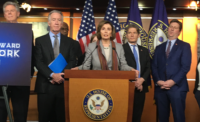The $825-billion economic stimulus proposal that House Democrats unveiled on Jan. 15 provides the first firm numbers for construction industry executives who for months have been searching anxiously for hints about the plan. Infrastructure advocates panned the proposal as far short of what is needed.

But with House of Representatives committee and floor votes and Senate action still to come, the package is far from the last word on the stimulus.
As drafted, the plan would have a major impact on construction. By ENR’s calculation, the package has about $135 billion in construction spending, or about one-fourth of the proposal’s $550-billion in total spending.
In addition, construction firms would benefit from some of the plan’s $275 billion in tax incentives, including an extension of a provision that allows small companies to write off the costs of equipment and other capital purchases in the year those items are bought.
President-elect Barack Obama, whose advisors worked with key lawmakers in designing the proposal, welcomed the House Democrats’ bill, calling it “a significant down payment on our most urgent challenges.”
But the proposal also drew quick and sharp criticism from some infrastructure advocates, who contend that it short-changes key public-works sectors.
Terence M. O’Sullivan, general president of the laborers’ union, said, “Any step forward is progress, but this level of investment falls far short of needs and fails to fully take advantage of the opportunity to put America back to work building the essential and long-neglected basics of our country.”
Rep. Peter DeFazio (D.Ore.), a senior Transportation and Infrastructure Committee member, said that by his calculation, “real infrastructure investment” would comprise only about 7.5% of the package, a level that he says is inadequate. DeFazio appeared to be referring to the $63 billion in the plan that would go to highways, transit, airports and other infrastructure programs under the Transportation committee's jurisdiction. Committee Chairman James Oberstar (D-Minn.) had proposed about $85 billion for those programs.
DeFazio suggested that the committee consider sending a letter or a resolution to House Democratic leaders, saying that “we need a much more substantial number on proven needs for projects that can put people to work and make our transportation more effective.”
House Speaker Nancy Pelosi (D-Calif.) said party leaders are “excited” about the proposal. But she cautions, “This is the first step along the way.” She said three major House committees, Appropriations, Ways and Means and Energy and Commerce, would vote on their portions of the legislation during the week of Jan. 19. Pelosi said a floor vote would take place the following week.
The measure then would go to the Senate. Pelosi said that House and Senate Democrats have “shared values” and “shared priorities.” But the Senate may well modify the House Democrats’ plan. Pelosi said, “We try to minimize the differences going in, but I would be surprised—and I am rarely surprised—if [House and Senate plans] would be identical.”
Appropriations Committee Chairman David Obey (D-Wisc.), who was in charge of drafting the $550-billion spending portion, said, “What it is, is simply the largest effort by any legislative body on the planet to try to take government action to prevent economic catastrophe.” But Obey added that even such a large package “may be insufficient” to meet that goal. Obey said, “We may need to do even more at a later date.”
The bill includes no earmarks, a fact that Democrats hope will speed passage and appease Republican concerns over perceived “pork” projects. Much of the $550 billion would be distributed to states or localities by existing formulas.
Transportation and renewable energy projects fare well in the package. In the transportation sector, the bill would provide $30 billion for highway and bridge construction projects and $9 billion for transit, although much of the transit aid could be used for non-construction capital spending, such as purchases of buses and railcars.
The bill also includes $1.1 billion for improvements to Amtrak and Intercity Rail projects; and $3 billion for airport improvement projects.
Energy is another major focus of the measure. It would provide $32 billion to develop a smart power grid to transmit renewable energy, and more than $20 billion in tax breaks for renewable-energy projects. Those incentives would include a multi-year extension of the production tax credit for wind, hydro, geothermal, and bioenergy projects.
In the environmental sector, the bill would provide $6 billion for the Clean Water State Revolving Fund; $2 billion for loans under the Drinking Water State Revolving Fund; $1.5 billion to support $3.8 billion in grants and loans for rural water and wastewater treatment systems. Approximately $2.3 billion would go for environmental cleanup projects, and $4.5 billion would go to U.S. Army Corps of Engineers environmental restoration projects.
The bill also would authorize $20 billion for school construction, including $14 billion for K-12 and $6 billion for higher-education projects.
In addition, the measure includes provisions to ensure transparency and accountability in the ways projects are funded. Those provisions include the establishment of a Recovery Act Accountability and Transparency Board, to include deputy secretaries and inspectors general from agencies that will receive stimulus funding. The board is charged with providing “early warning of potential management and funding problems, so that these can be addressed immediately,” the House Appropriations Committee said in its explanatory report on the bill.





Post a comment to this article
Report Abusive Comment